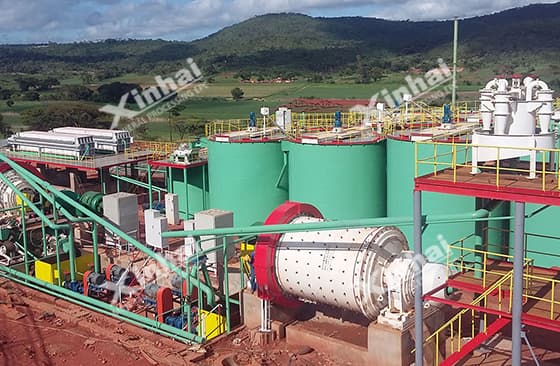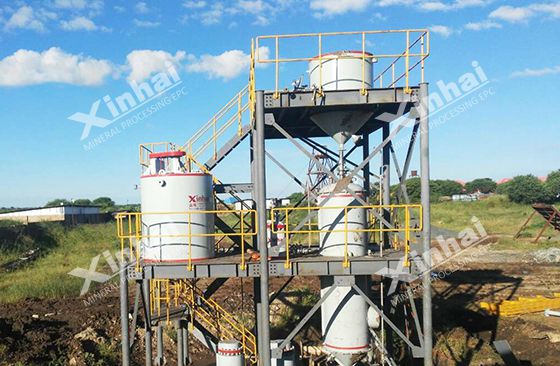
According to the difficulty of separation, gold ore processing can be divided into three levels: easy separation, complex separation and difficult separation. So for these three levels, what are their processing methods?
The gold ore with easy-separation is mostly oxide gold ore and sulfide gold ore. The gold recovery rate can generally reach more than 90%, and cyanide leaching is often used to recover gold supplemented by CIP or CIL. Since there is no solid-liquid separation, clarification and degassing of the concentrate solution is required. The ore usually needs 2~3 stages of crushing and 1~2 stages of semi-automatic grinding or rod grinding and ball grinding to make the feed particle size reach 85-75μm.
When the gold particles are coarse, gravity enrichment is finished before leaching. In this way, the separation of gold is more economical than the cyanide leaching-CIP (CIL) process, and the retention time of the leaching process is relatively short. For the gold ore with high silver content, the zinc cementation process can be used.

The characteristic of gold ore with complex separation is that it consumes a lot of cyanide or oxygen, or it exhibits the characteristics of internal competition.
1. Cyanide-consuming reagents processing method
When the copper sulfide ore content in the gold ore is high, copper flotation enrichment or chemical pretreatment is required for copper removal, and then a large amount of gold solution is used to recover and regenerate cyanide in the form of copper sulfate and copper sulfide. Moreover, the electrolytic pre-leaching can be used to remove the copper ore prior to CIP/CIL.

2. Oxygen-consuming processing method
Among ore materials that are hard to separate, divalent iron is easily oxidized to trivalent iron by chemical reagents, and sulfide is also oxidized to sulfate, so the active pyrite will increase the oxygen content during the reaction. Generally, in the ore separating process, the staff mostly choose to use pure oxygen, perchlorate and other oxidants to increase the precipitation. At the same time, the addition of oxidants can also be controlled by an electrode in the first stage.
If the active sulfide is a lean ore, selective flotation can be used to remove the easily oxidized sulfide in the flotation tailings after aeration. When the content of pyrite is low, pre-aeration with alkali can effectively cover the Fe3+ oxide film or hydroxide film on the surface of pyrite to passivate it. These surface films dissolve more slowly than pyrite in cyanide solutions, thus making it possible to efficiently conduct conventional cyanide leaching.

3. Internal competition processing method
Gold ores with the internal competition may be due to the presence of natural carbonaceous materials that can adsorb gold in the ores. For this type of gold minerals, Cl2 should be pre-oxidized (flash chlorination) to reduce the activity of carbonaceous materials. In addition, roasting and bacterial oxidation pretreatment can also eliminate internal competition, and then it can be leached with conventional cyaniding reagents, such as bromine, chlorine or thiourea.
The gold ore with difficult separation are defined because the mineral composition is difficult to distinguish. Some primary sulfides also belong to ores with difficult separation. Generally, a satisfactory recovery rate cannot be obtained by conventional cyanidation but it can be obtained after consuming a certain amount of cyanide or oxide, such as wrapped gold.

Wrapped gold means gold is wrapped on a substrate, such as being mechanically wrapped in sulfide ore, oxide ore and silicate and other minerals; wrapped in the form of alloys or compounds (silver-gold ore, gold-bearing telluride, etc.). It can be pre-heated by the physical method to separate on the premise of using a conventional ball mill for fine grinding with a grinding size of 100% < 28 μm or for ultra-fine grinding so that the discharge size is between 1 and 20 μm. In addition, several wet oxidation methods can be used to oxidize metal sulfides, such as nitrification oxidation, activated oxidation and slurry oxidation.
In the actual processing plant, different types of gold ores have different processing methods, To select a suitable gold ore process, it’s better to have processing tests to formulate reasonable gold processing methods according to the specific gold ore properties as well as characteristics.
To find out more about our products and solutions, please fill out the form below and one of our experts will get back to you shortly.